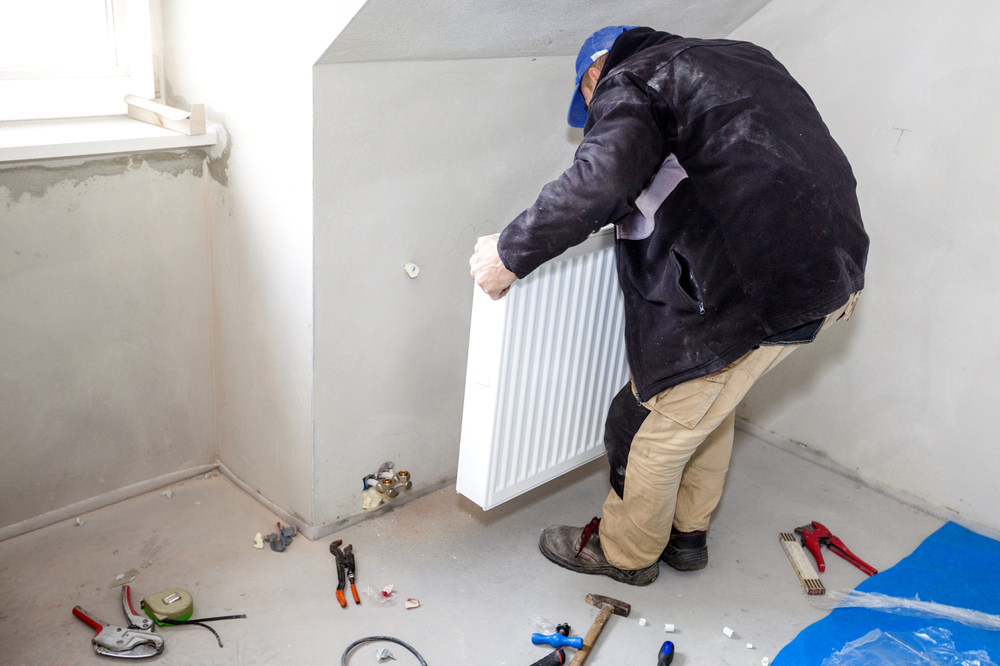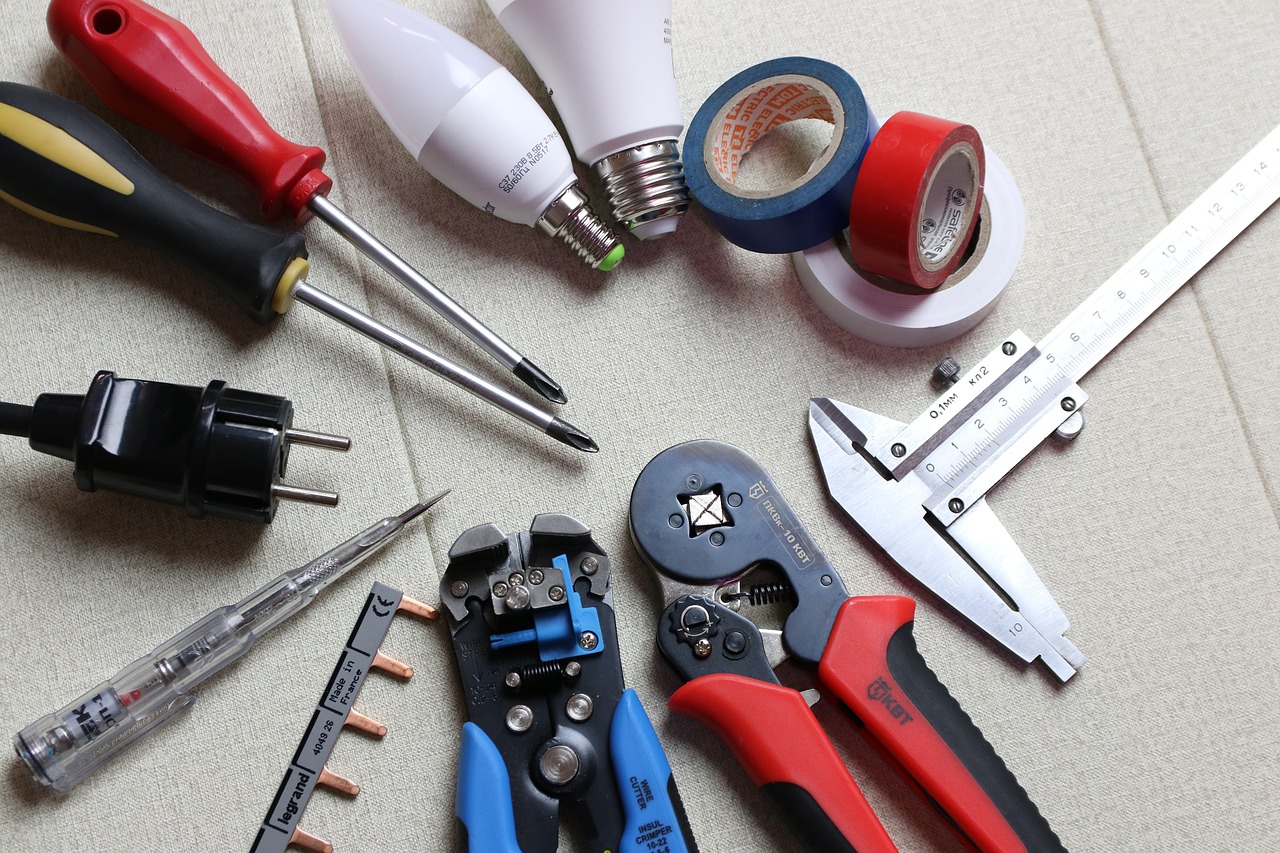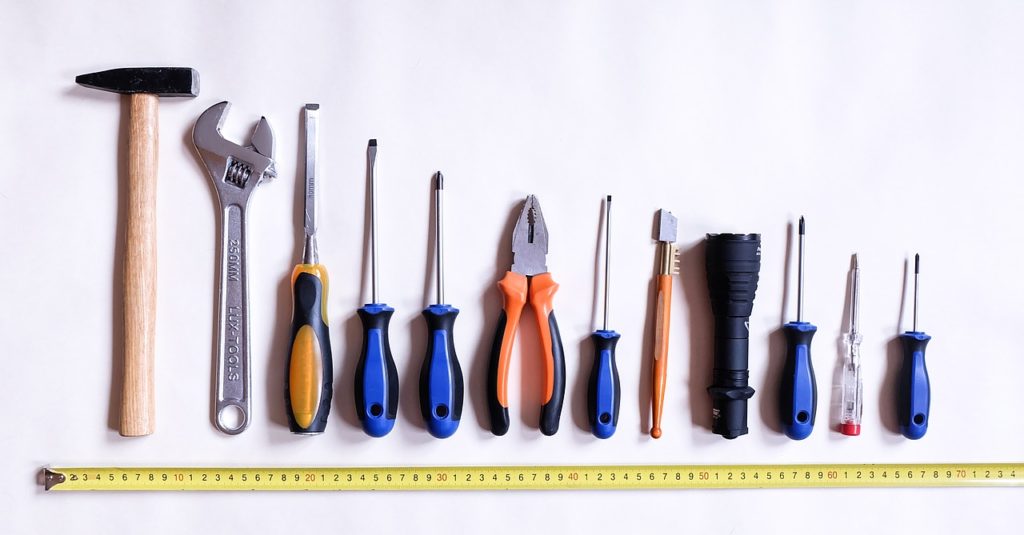When it comes to HVAC installer tools there’s a lot to sift through. Here’s a complete list of industry tools to help get you started as an HVAC technician!
Required HVAC Installer Tools
Below is a complete list of the most necessary HVAC installer tools and we haven’t overlooked a thing! These are the tools you will frequently need to use while working for a heating, air conditioning and ventilation company. If you are a technician or looking to pursue a career in the HVAC industry, you should be very familiar with all of these tools and know how to safely use them.

1. Battery Powered/Cordless Drill
One tool that is an absolute must is a cordless drill. HVAC installers often need to work in tight areas such as a crawl space or an awkward attic space where a corded drill may not reach. Bypassing a corded drill also can eliminate a tripping or electrocution hazard and therefore promotes safety. Find a drill that has a built-in work light and pick up the drill bit kits for both wood and metal so you’re prepared for it all.
2. Electrical Testers/Multimeter
Another necessary tool is an electrical tester, also called a multimeter. This tool works to check for electrical currents in all kinds of devices and wiring. It’s an important way to prevent electrocution and help point to problem areas. All electricians carry these devices, and it is a device that you will use time and time again to test outlets, batteries and practically everything that runs on electricity. Find a multimeter that is easily used with one hand and has a clear, lighted display like this Fluke 116 True RMS Digital Multimeter from Lennox– the leader in HVAC equipment.
3. Reciprocating Saw
HVAC technicians must be able to cut through metal pipes, pieces of wood, wires, brick, drywall or when working outside, and even stray branches that get in the way of the job. A sawzall, or reciprocating saw, is the best recommendation for a tool that can get through all of those materials. Sawzalls are versatile, can be cordless and are lighter than other saws. Some have a quick release feature that makes it fast and easy to replace the blades.
4. Tape Measure (25-footer)
As you’re doing your work, you will need to make many exact measurements and you never know how long of a measurement you’ll need until you’re on the job. Always bring a tape measure and make sure that it is 25 feet long or more to ensure you can get all the precise lengths you’ll need.
5. Step Ladder
When working inside of buildings and homes, you will often need to reach higher than you can with your feet on the floor. A four-foot step ladder should do the trick! This will be easier to carry and transport than a taller ladder, which you won’t need for most residential projects. Take into account the duty rating listed on the frame of the ladder to show how much weight it can safely support. Fiberglass framed ladders are more durable than the wood ladders and safer than aluminum ladders while working with electricity.
6. Hammer
Keep this trusty classic tool on your tool belt. The hammer you choose to carry should be one of lighter weight since you will be toting around a whole belt full of HVAC installer tools.
7. Extension Cord (50-footer)
You’ll need a good extension cord on your list of HVAC installer tools. Be sure to bring one that is long enough to reach a good distance, but not so long that it will be awkward to carry. We suggest going with a 50 ft. extension cord.

8. Screw Drivers
Add screw drivers to your must-have list of HVAC installer tools, and grab ones with insulated handles to prevent electric shock while you’re working. You will need screwdrivers of varying sizes and shapes. One way to have the variety you need without carrying a whole extra kit of tools is to buy an all-in-one screwdriver, like this 4-in-1 electronics rotating screwdriver.
9. Hex Head Nut Drivers
Some HVAC units are built using standard screws, but some are put together with hex heads. To install and repair this type of unit, you need to have a set of hex head nut drivers. Check out this 5-in-1 multi-nut driver that can function for the 6 most popular sizes.
10. Caulking Gun
Arm yourself with a dripless caulking gun for all of those seams that you need to seal. These come in handy when you’re doing ductwork and plugging other openings.
11. Level
Many heating and air conditioning units require leveling during installation. Pick up a magnetic level at the store and sit it on top of the metal units to free up your hands.
12. Pliers
Every HVAC technician should have a full set of pliers. Needle-nose, wire-stripping, and channel-lock pliers are a few that you will need, but you can find a nice set of insulated handle pliers like these at your local shop or online.
13. Pipe Wrench
The pipe wrench is the most commonly used tip wrench in the list for HVAC installer tools. Whether you need to attach or remove a pipe, you’re going to need a pipe wrench.
14. Tin Snips
When it comes to HVAC installer tools, regular scissors just won’t cut it. Tin snips will get through metal ductwork. There are three types of tin snips: left cutting, right cutting and straight cutting snips.

15. Shears
Add a pair of shears to your tool bag to help with the longer straight cuts that the tin snips can’t handle. Each tool has its purpose and you will find that your jobs will go smoothly and more quickly when you have each piece of the puzzle. Be sure to find a pair made of steel and also, just like the other HVAC installer tools, only buy a pair with insulated handles.
16. Folding Bar
It’s all in the name! One of the simplest looking items in the must-have list for HVAC installer tools is the sheet metal folding bar. For around ten bucks, you can pick up one of these straight bars that will be a life saver when you’re working with sheet metal. Each side of the bar has a slot of different measures to give you a precise bend on some longer pieces of metal at the angle you need.
17. Hand Seamers
Keep a hand seamer close by when working with sheet metal. Like the folding bar, it helps create straight seams at whatever angle you need but it’s actually better for smaller bends than the folding bar.
18. Crimpers
As you work on fitting pipes together, a crimper will help create the crimped edge needed to fit directly into the un-crimped side of another pipe. Crimpers can also double as wire strippers or metal cutters when needed.
19. Awl
The purpose of these small, simple HVAC installer tools is to poke holes in wood or metal. You can also use it to score the metal to mark your cut lines.
20. Heavy Duty Staple Gun
Heavy duty staple guns are a necessary tool when you’re tacking up insulation or attaching sheet metal or foil-covered cardboard panning to joists. Keep this in your tool bag along with industrial-grade staples.

HVAC Installer Tools for Air Conditioning
Are you installing or repairing an air conditioning unit? These are the tools that you’ll need to finish the job!
21. Tubing Cutter
A tool specifically for HVAC installations, the tubing cutter cuts the strong copper pipes used in air conditioning units. It can be used to cut other materials as well. Just be patient when cutting because it takes a little time to pressure the pipes to cut all the way through and rushing it will damage the material.
22. Manifold Gauges
Whether you use a digital or analog manifold gauge, all HVAC installers must utilize these tools when testing an air conditioning system and checking for leaks. This useful contraption can also do recharges and evacuations.
23. Vacuum pump
One of the last steps of repairing an air conditioning unit will require this HVAC installer tool. The air compressing vacuum pump creates a vacuum and eliminates any leftover gas, air or water in the unit’s system.
24. Refrigerant scale
Without a reliable scale, you won’t know how much refrigerant to use when recharging or installing a new air conditioner. The model you need will depend on the type and size of the units you’re working on.
25. Core Removal Tool
Another help when repairing air conditioner units is a core removal tool. Valve cores restrict the flow of the refrigerant by a very high percentage. Removing them with this tool allows a much faster recovery or evacuation process while making it easily possible to return the core to position once the job is complete.
26. Coil Fin Straightener or Fin Comb
This little tool helps to straighten bent fins on the condensing unit for an air conditioner. The fins bend for all kind of reasons, usually because of strong weather sending branches into the unit or sometimes there are other man-made factors. No matter what the reason, the bent compressor fins restrict airflow to the unit making it less efficient in its cooling job.
27. Refrigerant Recovery Machine
Last but not least on the list of HVAC installer tools specifically for air conditioners: the refrigerant recovery machine. Due to rules and regulations set by the EPA, these machines are not only useful but are now required in order to safely recover and properly dispose of used refrigerant. These units come in single cylinder and twin-cylinder styles all of which have varying recovery times which is an important detail to consider.

General Supplies Used by HVAC Installers
Not all of your HVAC installer tools need to come from a specialty HVAC supplier. There are some general supplies that you’ll need, too, and you might already have some of these in your truck or back at home.
28. Flashlights and Headlamps
As an HVAC technician, you will often work in dimly lit places. Good sources of light are a necessity and having a headlamp for the ability to work with both hands free is also important for these kinds of jobs. Find one with a rechargeable battery and you’ll save money over the long term.
29. Wet/Dry Vac
While vacuums aren’t necessarily thought of as HVAC installer tools, they can quickly clean up a mess! Keep a wet/dry vacuum with you to make cleanup easier.
30. HVAC Installer Tools Safety Equipment
Don’t overlook or underestimate the importance of safety. Be sure to buy yourself a quality pair of gloves, safety glasses, work boots and even ear plugs to ensure that you will be properly prepared!
Check Off Your List of HVAC Installer Tools
Now that you know what you’ll need, go through your existing inventory and check off every item on our list of HVAC installer tools. If you always have the tools you need to complete a job quickly and properly, you will earn a great reputation as a reliable HVAC expert – and that’s how you build your business and provide great service!

